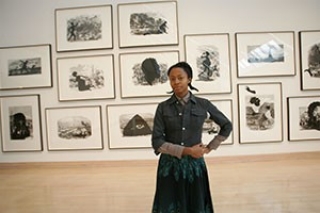Born 1969, Stockton, California
Kara Walker once explained her artistic process as “two parts research and one part paranoid hysteria,” a description that captures the entanglement of history and fantasy that pervades her work.[1] These themes come together most notoriously in immersive installations of cut-paper silhouettes, in which Walker’s projects critically employ racist stereotypes to expose slavery’s foundation in eroticized violence. Accounts of enslavement are not bygone occurrences in her satirical art, but volatile melodramas with lingering psychological effects. Her stock characters inhabit a topsy-turvy world set in the antebellum South and magnify the grotesque dynamics of race and gender that conventional narratives frequently suppress.
Walker earned a BFA at the Atlanta College of Art and an MFA at the Rhode Island School of Design, both in painting and printmaking. Now based in New York, she has also executed drawings, pop-up storybooks, shadow puppet animations, and monumental sculptures, at times incorporating materials like coffee and sugar to add historical resonances to her examinations into the legacies of American slavery. Connecting these diverse media is the ambition of a traditional history painter, who mines the archive of social history to picture abstract ideas with political, and therefore public, significance.
The controversy incurred by Walker’s use of stereotypes highlights the vexing public roles that African American artists from Walker’s generation were to assume. In 1997 veteran African American artists publicly condemned her work, viewing it as shameless, self-serving, and divisive. Yet despite facing boycotts and censorship, Walker continues her relentless explorations of racism’s power and contradictions, implicating both artist and audiences in extending its destructive logic into the present.
In Harper’s Pictorial History of the Civil War (Annotated) her targets are fifteen popular images published in 1866 that represented the war as a narrative driven by primarily white actors. Walker’s appropriations offer a potent alternative to these purported documentary depictions. After enlarging the original wood engravings, she has overlaid them with silkscreened silhouettes of figures who, by turns, stalk, occupy, lumber across, and violently explode onto the scenes of their historical erasure.
Elaine Yau
[1] Kara Walker, “Stories,” Art21: Art in the Twenty-First Century (season 2,
2003), https://art21.org/artist/kara-walker/ (accessed September 14, 2016).
Berry, Ian, et al. Kara Walker: Narrative of a Negress. Cambridge, MA: MIT Press, for the Frances Young Tang Teaching Museum and Art Gallery, Skidmore College, Saratoga Springs, NY, 2003.
Shaw, Gwendolyn Dubois. Seeing the Unspeakable: The Art of Kara Walker. Durham and London: Duke University Press, 2004.
